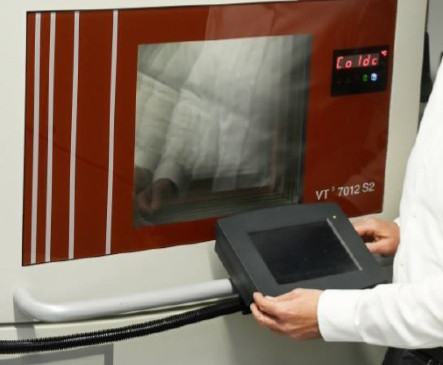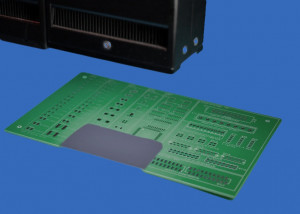We take a look at innovations for the production of printed circuit boards and special electronic components.
Solder paste for Mini/MicroLEDs
As a material supplier for the electronics, semiconductor, thin film and thermal management markets, Indium is expanding its portfolio with a new halogen-free no-clean solder paste for LED assembly varieties such as COB, COG, SMT and others. The NC38HF LED paste combines good wetting properties with high mask transfer efficiency for a wide range of MiniLED applications. It is printable at apertures down to 60 µm. MiniLEDs typically have a length of less than 240 µm. The new material offers compatibility with the current and future dimensions of miniLEDs.
The NC38HF indium paste offers consistent and dense solder paste application over multiple prints and good pause behavior during manufacturing, minimal voiding with tight pitch components, industry-leading non-wet-open performance due to a special oxidation barrier, minimal bridging during the assembly process and higher yields with tight-pitch assembly.
Solder paste for SMT applications in the automotive sector
At the 2023 IPC Apex Expo, Heraeus Electronics presented products for current and future challenges of SMT assembly in the context of ongoing miniaturization, increasing reliability and higher thermal (TCO) requirements. The new paste system from Heraeus allows a wide process window for soldering in a free atmosphere with a low defect rate. In addition, its optimized composition is aimed at lower material costs.
In this context, Heraeus demonstrated its proven Innolot solder paste and the mAgic DA320 sinter paste. The SMT 650 Innolot solder paste achieves a consistently higher resistance to surface insulation, which suppresses electrochemical migration. The combination of the flux system with the Innolot alloy provides high reliability, especially of miniaturized systems in automotive manufacturing. The flux system can also be combined with SAC305.
As a pressure-free applied sinter paste, mAgic DA320 achieves high shear strength for die attach procedures in power electronics. It offers high thermal conductivity and fast sintering at low processing temperatures from 200 °C for stable connections.
Solder resist with high hardness and scratch resistance
 The solder resist is tested under extreme conditions in the new test cabinet in the climate laboratory
The solder resist is tested under extreme conditions in the new test cabinet in the climate laboratory
The Elpemer solder resist SD 2463 FLEX-HF from Lackwerke Peters is ideal for rigid-flex and semi-flex printed circuit boards. It is available in the transparent colors green and amber. In addition to the three features 'easy spray or screen printing application', 'direct or contact exposable' and 'flex-to-install', it is free from harmful SVHC photoinitiators ('Substances of Very High Concern') such as 369 or 907.
For flexible electronic circuit carriers, SD 2463 FLEX-HF is suitable for all areas of application due to its physical and mechanical properties. According to the laboratory management, 'flex-to-install' means that the varnish is flexible against the bending stress during installation of the PCB. The strength of the solder resist lies in its ability to reliably cover the areas of a PCB that should not accept solder during soldering processes. High hardness and scratch resistance after final curing can protect the PCB from mechanical damage during further handling.
The solder resist SD 2463 FLEX-HF is used in the automotive and aerospace sectors. The field of application has also expanded to include sensor and medical technology. Examples include hearing aids, which require multiple folded flexible printed circuit boards with minimal space requirements. The bending diameters are very small at 1 mm. The solder resist SD 2463 FLEX-HF has been used by manufacturers for flex, rigid-flex and HDI substrates for several years.
Protective lacquer withstands extreme frost
The protective coating Elpeguard SL 1800 FLZ is characterized by its high temperature flexibility. The new product from Peters research exceeds the industrial standard for cold-flexible acrylates by 25 °C. This means that the protective coating does not show any negative effects even when exposed to temperature shocks of +125 to -65 °C. "For the automotive and aviation sectors, it is now necessary to penetrate extreme frost layers above the low point of -40 °C. Peters refers to long-term tests in the climate laboratory with the latest generation VT³ 7012 S2 temperature shock system. Here, components and circuit boards are exposed to rapid temperature changes between -80 and +220 °C.
The modified acrylate is particularly suitable for physically drying thin-film coatings. The coating is also characterized by good wetting of silicone-contaminated surfaces with the protective coatings of the SL 1801 FLZ series.
Black adhesives for UV curing
 A black epoxy coating with a thickness of 1 mm is cured with UV LED light
A black epoxy coating with a thickness of 1 mm is cured with UV LED light
With the 'Black&Light' adhesives, Panacol has developed black epoxy resin adhesives from the Vitalit product range, which are also cured in thicker layers with UV radiation without resorting to secondary curing mechanisms. With conventional black UV adhesives, the black color absorbs a high proportion of the UV intensity. As a result, the energy required to fully polymerize an adhesive can only penetrate a few µm, resulting in skin formation on black adhesives, but not full cure. The majority of black adhesive must be cured in a secondary thermal curing step at temperatures in excess of 100°C.
Vitalit adhesives allow full curing from a few 100 µm up to 1 mm thickness. The adhesives are suitable for various encapsulations, glob tops or edge bonders in electronics production as well as for optical adhesive systems where high OD values ('optical density') are required in optoelectronic applications, for example to minimize reflections or to achieve certain transmission values for sensors.
In a production process, the appropriately dosed black adhesive is cured at the right wavelength and intensity, with the UV rays penetrating the entire adhesive system once. After polymerization, the structures of the epoxy resin close again. The result is a fully cured adhesive of lasting blackness.
The 'Black&Light' technology is compatible with other Vitralit epoxy resin adhesives and can be combined depending on the requirement for blackness and the required curing depth. There are advantages in terms of storage: while conventional black epoxy resin adhesives usually have to be stored deep-frozen, 'Black&Light' adhesives can be stored and shipped at room temperature or at maximum refrigeration.
www.indium.com
www.heraeus-electronics.com
www.peters.de
www.panacol.de


